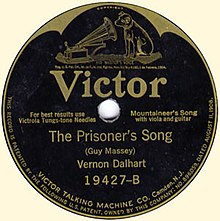The Prisoner's Song
The Prisoner's Song is an American country song . Text and melody are by Guy Massey , who probably knew the piece from his brother Robert Massey , who probably heard it - or some version of it - while serving a prison sentence. The song was published in 1924 with the registered copyright of Vernon Dalhart in the music publisher Shapiro and Bernstein. In the recording by Vernon Dalhart, it was the first million dollar hit in American old-time and country music.
background
Massey sang the song to his cousin Vernon Dalhart, who then recorded it on August 13, 1924 and published it as the B-side of his cover version of the event song The Wreck of Old 97 (Victor 19427) about the Old 97 railway accident in Danville . Unit manager Nat Shilkret had added more lines of text to the song before the first record was made; Dalhart had the copyrights registered in his name, but paid his cousin five percent of the royalties until his death .
The song's simple melody consists of five stanzas with alternating endings; the simple accompaniment based on three chords underlines this. In the sections where Dalhart does not sing, a violin plays the melody, towards the end an obligato . The lyrics, which are about a poor man separated from his beloved wife, are similar to the folk song Lonesome Valley .
The record recording (Victor 19427) became the most commercially successful Victor shellac record in the pre-electric era. The data on record sales vary between (occupied) 1.7 million and allegedly seven million copies. The song was in the US charts for 32 weeks, twelve of them at # 1. Dalhart recorded the song (under different names) in the following years for 27 other record labels.
First recordings and later cover versions
Dalhart also recorded the song for Columbia Records under the direction of Ross Gorman ; the version on which u. a. Red Nichols contributed but remained unpublished for many years. Vera Guilaroff ( Piano Roll ) and the Savoy Orpheans ( His Master's Voice ) were among the other musicians who covered the song from late 1924 . The Prisoner's Song has also been performed by a number of jazz musicians ; the discographer Tom Lord lists a total of 24 (as of 2016) cover versions , u. a. by Philip Lewis, Wingy Manone , Bunny Berigan , Kai Ewans , Seymour Österwall , Dave Brubeck , Kay Starr , Georgie Auld , Louis Armstrong , Rusty Dedrick , Glen Gray , Billy May and Lars Edegran . The Prisoner's Song was performed by Al Bowlly / Ray Noble Orchestra, and in later years by Eddy Arnold , Chet Atkins , Hylo Brown , Sonny Burgess , Frankie Carle , Wilf Carter , Johnny Cash , Fats Domino , Duane Eddy , Brenda Lee (under the title Someone to Love Me ), Bill Monroe , George Reneau , Hank Snow , Warren Storm , Slim Whitman and Mac Wiseman . A cartoon of the same name was made in the Fleischer studios in 1930 .
The Association of the Music Industry in the United States (RIAA) added the piece to its Songs of the Century list .
Web links
- Inclusion in the catalog of the German National Library: DNB 352894474
Individual evidence
- ↑ The exact authorship of the song is unclear; According to Guy Massey's widow, the song was written by Guy's brother Robert. See Sean Williams, Lillis O Laoire: Bright Star of the West: Joe Heaney, Irish Song Man . 2011, p. 173
- ↑ Quotes on bobdylanroots.com There it says u. a .: "Guy Massey did not write this song. His brother, Robert Massey, wrote it. Guy always stayed with us when he came to Dallas, and I was with them while my husband sang it and Guy wrote it down. ”Dorothy Horstman, telephone interview, January 21, 1974, printed in: Dorothy Horstman: Sing Your Heart Out, Country Boy, New York, 1976, p. 300
- ↑ Don Cusic: Gene Autry : His Life and Career . 2007, p. 11.
- ^ Norm Cohen: Folk Music: A Regional Exploration . 2005, page xix
- ↑ Russell Sanjek: American Popular Music and Its Business: The First Four Hundred Years. 1988, p. 100.
- ^ Michael Campbell Popular Music in America: The Beat Goes On . 2012
- ↑ a b Don Tyler: Hit Songs, 1900-1955: American Popular Music of the Pre-Rock Era . Jefferson, North Carolina & London, McFarland, 200, pp. 140f.
- ^ Ted Fagan, William R. Moran: The Encyclopedic Discography of Victor Recordings, Pre-Matrix Series. Westport, Conn., 1983, pp. Lxii. ISBN 0-313-23003-X
- ↑ Tim Brooks: Pop Memories 1890-1954: The History of American Popular Music ARSC Journal (Association for Recorded Sound Collections) 21 (1), November 26, 1989
- ↑ In one of these versions, published under the name The International Novelty Orchestra (Victor 19714), he was accompanied by Nat Shilkrets Orchestra. Dalhart recorded the song under his own name for Cameo Records (# 703) Cameo Records in 78discography , Brunswick (# 2900) and as Imperial Dance Orchestra with Vernon Dalhart (Domino 3663).
- ↑ a b Tom Lord: The Jazz Discography (online)
- ↑ Guy Massey at Discogs (English)

